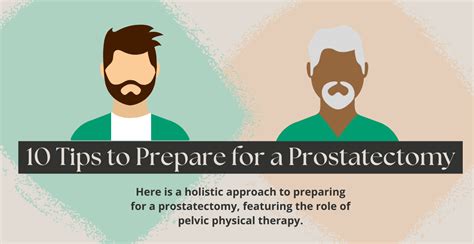Intro
Prostate surgery, also known as prostatectomy, is a common treatment option for prostate cancer, benign prostatic hyperplasia (BPH), and other prostate-related conditions. The recovery process after prostate surgery can be challenging, but with proper care and attention, most men can make a full recovery. In this article, we will explore the importance of prostate surgery recovery, the benefits of a well-planned recovery process, and provide valuable insights and tips to help men navigate this critical phase.
The recovery process after prostate surgery is crucial, as it can significantly impact the outcome of the surgery and the overall quality of life. A well-planned recovery process can help minimize complications, reduce discomfort, and promote a speedy return to normal activities. Moreover, a smooth recovery can also reduce the risk of long-term side effects, such as incontinence, impotence, and infertility. Therefore, it is essential to understand the recovery process and take proactive steps to ensure a successful outcome.
Prostate surgery recovery is a complex process that involves physical, emotional, and psychological aspects. The recovery process can be influenced by various factors, including the type of surgery, overall health, age, and lifestyle. For example, men who undergo robotic prostatectomy may experience less pain and faster recovery compared to those who undergo traditional open surgery. Similarly, men who are physically active and have a healthy diet may recover faster than those who lead a sedentary lifestyle. Understanding these factors can help men prepare for the recovery process and make informed decisions about their care.
Understanding Prostate Surgery

Types of Prostate Surgery
There are several types of prostate surgery, including: * Radical prostatectomy: This is a surgical procedure that involves removing the entire prostate gland and surrounding tissues. * Laparoscopic prostatectomy: This is a minimally invasive surgical procedure that involves removing the prostate gland through small incisions in the abdomen. * Robotic prostatectomy: This is a type of laparoscopic prostatectomy that uses robotic technology to enhance precision and reduce recovery time. * Transurethral resection of the prostate (TURP): This is a surgical procedure that involves removing part of the prostate gland through the urethra.Preparation for Prostate Surgery Recovery

Creating a Recovery Plan
Creating a recovery plan can help men prepare for the recovery process and ensure a smooth transition from the hospital to home. A recovery plan should include: * A list of medications and dosages * A schedule for follow-up appointments * A plan for managing pain and discomfort * A plan for managing urinary incontinence * A plan for managing erectile dysfunctionPhysical Recovery After Prostate Surgery

Managing Pain and Discomfort
Managing pain and discomfort is a critical aspect of physical recovery after prostate surgery. Men can take several steps to manage pain and discomfort, including: * Taking medication as directed * Applying ice packs to the affected area * Taking regular breaks to rest and relax * Engaging in gentle exercises to promote healing and reduce stiffnessEmotional and Psychological Recovery After Prostate Surgery

Managing Anxiety and Depression
Managing anxiety and depression is a critical aspect of emotional and psychological recovery after prostate surgery. Men can take several steps to manage anxiety and depression, including: * Seeking support from family and friends * Engaging in counseling or therapy * Practicing stress-reducing techniques, such as meditation and deep breathing * Taking medication as directedReturning to Normal Activities After Prostate Surgery

Creating a Rehabilitation Plan
Creating a rehabilitation plan can help men promote a return to normal activities after prostate surgery. A rehabilitation plan should include: * A schedule for follow-up appointments * A plan for managing pain and discomfort * A plan for managing urinary incontinence * A plan for managing erectile dysfunction * A plan for promoting wound healingWhat are the risks and complications of prostate surgery?
+The risks and complications of prostate surgery include urinary incontinence, erectile dysfunction, infertility, and infection. However, these risks can be minimized with proper care and attention.
How long does it take to recover from prostate surgery?
+The recovery time after prostate surgery can vary depending on the type of surgery and overall health. However, most men can expect to make a full recovery within 6-12 weeks.
What are the benefits of prostate surgery?
+The benefits of prostate surgery include improved urinary function, reduced risk of prostate cancer, and improved quality of life. However, the benefits of prostate surgery can vary depending on the individual and the type of surgery.
In
